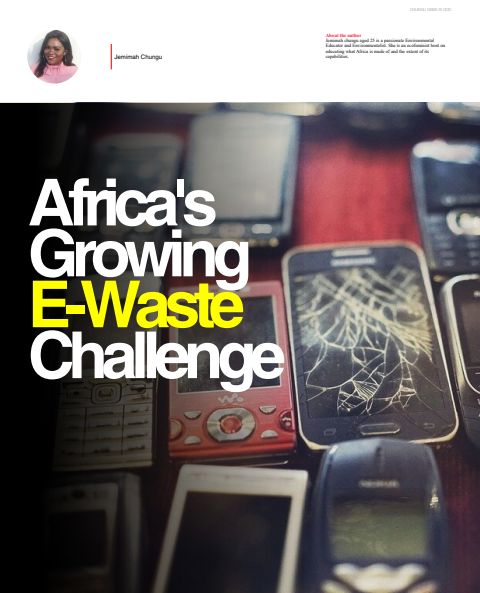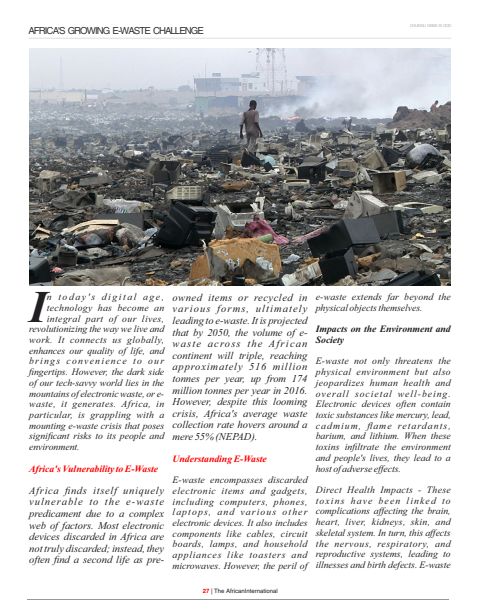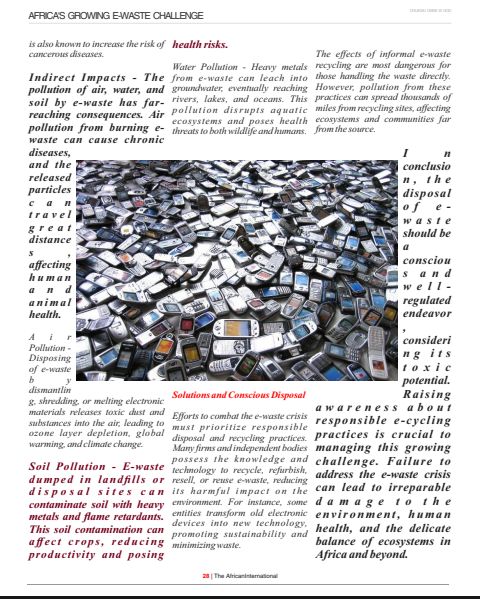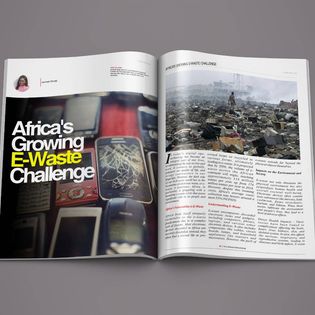
By Jemimah Chungu

In today’s digital age, technology has become an integral part of our lives, revolutionizing the way we live and work. It connects us globally, enhances our quality of life, and brings convenience to our fingertips. However, the dark side of our tech-savvy world lies in the mountains of electronic waste, or e-waste, it generates. Africa, in particular, is grappling with a mounting e-waste crisis that poses significant risks to its people and environment.
Africa’s Vulnerability to E-Waste
Africa finds itself uniquely vulnerable to the e-waste predicament due to a complex web of factors. Most electronic devices discarded in Africa are not truly discarded; instead, they often find a second life as pre-owned items or recycled in various forms, ultimately leading to e-waste. It is projected that by 2050, the volume of e-waste across the African continent will triple, reaching approximately 516 million tonnes per year, up from 174 million tones per year in 2016. However, despite this looming crisis, Africa’s average waste collection rate hovers around a mere 55% (NEPAD).
Understanding E-Waste
E-waste encompasses discarded electronic items and gadgets, including computers, phones, laptops, and various other electronic devices. It also includes components like cables, circuit boards, lamps, and household appliances like toasters and microwaves. However, the peril of e-waste extends far beyond the physical objects themselves.
Impacts on the Environment and Society
E-waste not only threatens the physical environment but also jeopardizes human health and overall societal well-being. Electronic devices often contain toxic substances like mercury, lead, cadmium, flame retardants, barium, and lithium. When these toxins infiltrate the environment and people’s lives, they lead to a host of adverse effects.
Direct Health Impacts – These toxins have been linked to complications affecting the brain, heart, liver, kidneys, skin, and skeletal system. In turn, this affects the nervous, respiratory, and reproductive systems, leading to illnesses and birth defects. E-waste is also known to increase the risk of cancerous diseases.
Indirect Impacts – The pollution of air, water, and soil by e-waste has far-reaching consequences. Air pollution from burning e-waste can cause chronic diseases, and the released particles can travel great distances, affecting human and animal health.
Air Pollution – Disposing of e-waste by dismantling, shredding, or melting electronic materials releases toxic dust and substances into the air, leading to ozone layer depletion, global warming, and climate change.
Soil Pollution – E-waste dumped in landfills or disposal sites can contaminate soil with heavy metals and flame retardants. This soil contamination can affect crops, reducing productivity and posing health risks.
Water Pollution – Heavy metals from e-waste can leach into groundwater, eventually reaching rivers, lakes, and oceans. This pollution disrupts aquatic ecosystems and poses health threats to both wildlife and humans.
Efforts to combat the e-waste crisis must prioritize responsible disposal and recycling practices. Many firms and independent bodies possess the knowledge and technology to recycle, refurbish, resell, or reuse e-waste, reducing its harmful impact on the environment. For instance, some entities transform old electronic devices into new technology, promoting sustainability and minimizing waste.

Solutions and Conscious Disposal
The effects of informal e-waste recycling are most dangerous for those handling the waste directly. However, pollution from these practices can spread thousands of miles from recycling sites, affecting ecosystems and communities far from the source.
In conclusion, the disposal of e-waste should be a conscious and well-regulated endeavor, considering its toxic potential. Raising awareness about responsible e-cycling practices is crucial to managing this growing challenge. Failure to address the e-waste crisis can lead to irreparable damage to the environment, human health, and the delicate balance of ecosystems in Africa and beyond.


